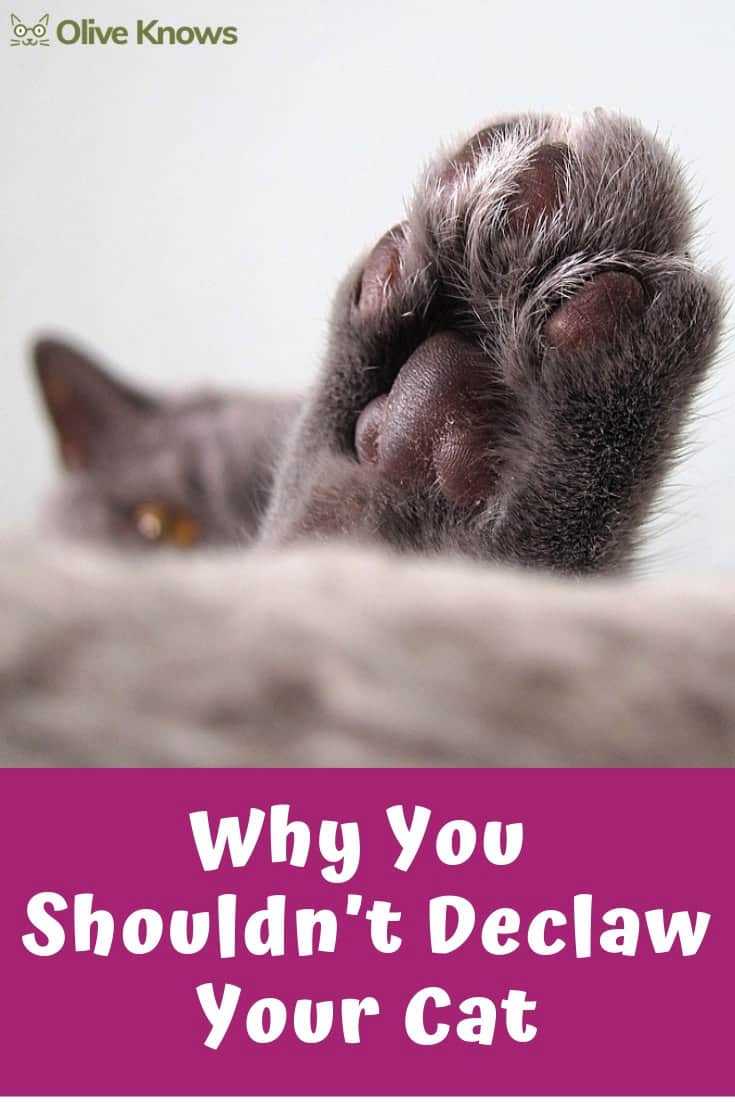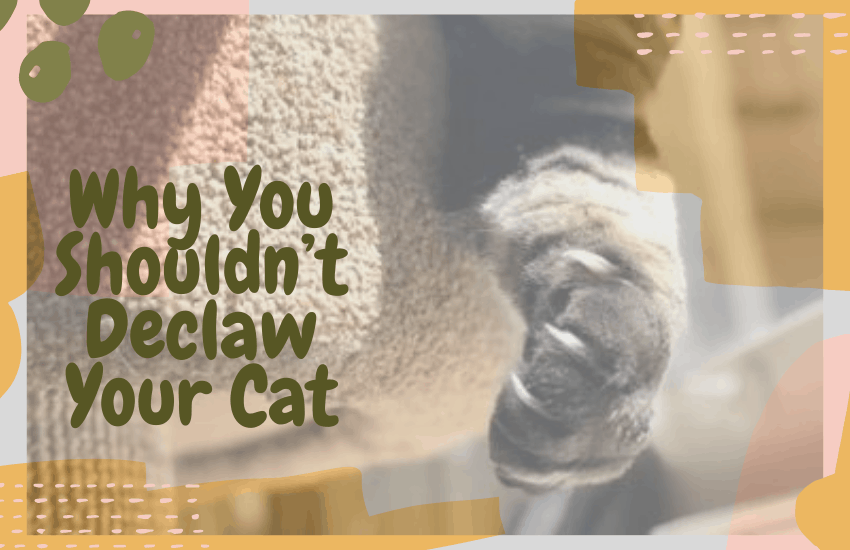
Declawing your cat is unfortunately still common in the US. The procedure is illegal in many countries because it’s considered inhumane. So why is it still almost a routine procedure when someone gets a new cat?
Most people get the cat declawed because they don’t understand exactly what declawing does to their cat. As a loving cat parent, you want to understand why you should avoid declawing and what you can do to keep your cat from scratching what they shouldn’t.

Table of Contents
Anatomy of Your Cat’s Paws and Claws
Your cat’s paws and claws are different from your hands and fingernails. Understanding the difference will help you know why declawing a cat is cruel.
Losing a fingernail or toenail for a human might be painful, but not a significant life-altering event. But a cat losing its claws is not just painful, but totally life-altering and often traumatic.
Cats have an instinctive desire to scratch to sharpen their claws, mark their territory, and just because it feels good.
Cat Claws
A cat’s claw is quite different from your human fingernail. It grows directly out of the last bone on your cat’s paw. To remove the claw and prevent it from growing back, the claw and at least part of the bone it is attached to must be completely removed.
Some veterinarians shy away from the word “amputation” because it makes people more uncomfortable with the procedure, but that’s really what it is. Declawing a cat is amputating the last bone from each toe.
Cat Paws
Cats walk on the balls of their feet and their toes. The very same toes that their claws extend from. For the claw and bone to be removed, your cat’s paw pad is likely to be sliced in half. This will cause discomfort walking for your cat for weeks.
It also makes it difficult to keep your cat’s paws properly bandaged while they heal. Cats don’t like things stuck to their paws and will sometimes go to great lengths to remove the bandages.
Cats also have scent glands on their toes that help with scent marking their territory when they scratch. If you remove their ability to scratch and leave a scent, your cat may choose to urinate to mark their territory instead.
Read our full guide on how to restrain your cat to clip her nails.
Types of Declawing Procedures
There are two ways a cat can be declawed. Both involve surgery and have significant recovery times for your cat. There are also potentially serious complications with both kinds of surgery.
Onychectomy
Onychectomy is the total removal of your cat’s claw. Since the claw can grow back if the bone is left, the bone the claw grows out of is also removed. On a human hand, it’s the equivalent of cutting off your fingers at the first joint.
Common Technique
The most common way to declaw a cat is using a small tool similar to a guillotine to remove the claw and first bone on the end of the cat’s paw. This technique involves slicing through half of your cat’s paw pad as well. This increases your cat’s discomfort in recovery since the paw pad is what your catwalks on.
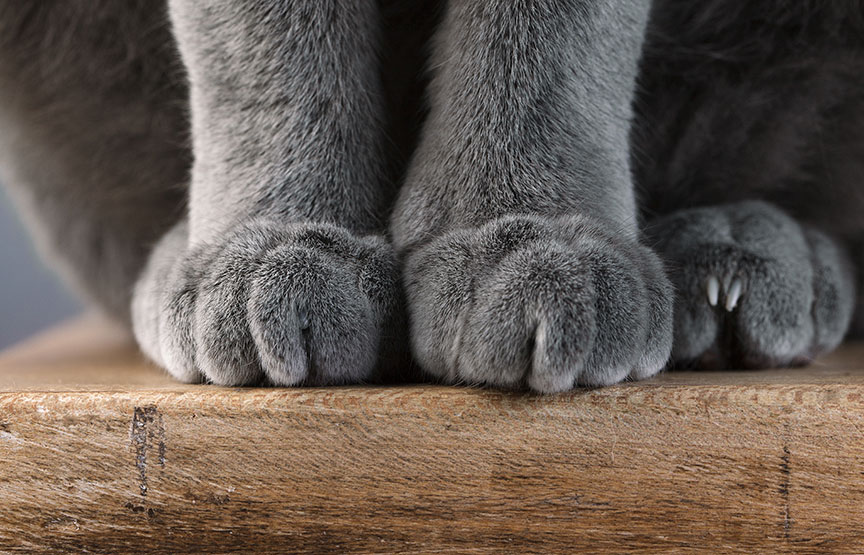
Cosmetic
The cosmetic technique leaves your cat’s paw pad intact. This method removes a small piece of the bone the claw is attached to. As this process is difficult and takes more time, so many veterinarians don’t actually offer this type of declawing.
Laser
Some veterinarians may offer laser surgery to remove the claw and first bone of your cat’s paw. The use of laser surgery is another controversial topic within the debate surrounding cat declawing. While laser surgery causes less bleeding and pain for your cat, it is far more expensive. It still requires your cat going under anesthesia, and there is a risk that the person using the laser may not have sufficient training to use it effectively.
Tendonectomy
A tendonectomy involves slicing the ligament on your cat’s paw that allows the claws to extend. The claws are left intact, but your cat can no longer use them.
The incision is small and doesn’t even require stitches. But the time it takes for your cat to walk comfortably again after surgery is about the same as a declawed cat. Satisfaction for the pet parent is not statistically higher than other methods of declawing. As the claws are left, but your cat can no longer scratch to maintain them, you must regularly trim your cat’s claws to prevent ill effects.
Complications
As with any surgery, human or cat, there is risk of complications with lasting negative side-effects. These can be short-term side effects or permanent. Your cat may experience physical or behavioral issues. It’s important to know what you and your cat might deal with on the other side of surgery should you choose to declaw your cat.
Physical Side Effects
The first issue with unnecessary surgery is the risk of physical side effects. When there is a possibility of permanent negative effects, is the risk really worth it?
Surgery Gone Wrong
A botched surgery can mean life-long pain for your cat. Bone damage or nerve damage can be caused by a careless or over-zealous surgeon. If not all of the claw tissue is removed, the claw will attempt to re-grow. This will cause your cat pain, infection, and require a second surgery to fix the first one.
Your cat could also be left lame from a botched surgery. This could be a temporary limp or permanent pain for your cat. Your cat could also be left with back pain for the rest of their life if declawing affects how they walk.
Infection
Even if all goes well with surgery, your cat still faces the risk of infection. Your cat will likely be prescribed antibiotics to help prevent infection, but it can still happen with the best of care.
Keeping the surgical site clean is difficult because your cat is walking on the paws, directly where the sutures are. To make it worse, your cat’s litter box increases the chances of your cat’s paws becoming infected. Infection unnoticed and unchecked can spread and result in more pain and discomfort for your cat.
Behavioral Side Effects
Emotional side effects are as important as the physical side-effects, both for you and your cat. Losing their claws means a cat loses its main defense as well as one of their means of communication (marking). This can cause temporary behavioral issues or form lifelong changes to your cat’s personality.
Litter Box
Walking on the litter in your cat’s litter box may be painful for your cat after surgery. This could cause your cat to decide to do their business elsewhere to avoid the pain.
If you swap out the kind of litter in your cat’s litter box for a softer kind that won’t hurt, your cat may not like the sudden change and still decide to move their bathroom to another location. It’s also possible that your cat may begin to urinate to mark their territory since they can no longer scratch to do so.
Biting
There are many accounts of cats that didn’t start biting until after they were declawed. Between a traumatic amputation, weeks of recovery and pain, and an inability to climb or defend themselves, cats don’t respond well to declawing.
Your cat may become more aggressive, or despondent and withdrawn. There is no way to predict how each individual cat will respond to the sudden loss of their claws. But taking the risk with unnecessary surgery is not worth it.
Legitimate Reasons to Declaw Your Cat
Most reasons considered legitimate for declawing a cat is to ensure that the cat can remain in their current household. One such example would be if the owner was at a high health risk and declawing the cat would help lower the risk from scratches. However, when you get a new cat, declawing them should not be considered a routine procedure.
Alternatives to Declawing
So you’ve decided you don’t want to declaw your cat. But you still don’t want your cat to scratch you or your furniture. What do you do? There are plenty of ways to discourage your cat from scratching what they shouldn’t, and to protect yourself from mean kitty scratches.
Nail Trimmers
Good quality nail trimmers will help you keep your cat’s claws in good condition. Since one reason that cats scratch is grooming, this is essential for any cat’s claws. If you are careful when trimming the claws, you can minimize the discomfort of the process for you and your cat.
Fur Goodness Sake Cat Clipper
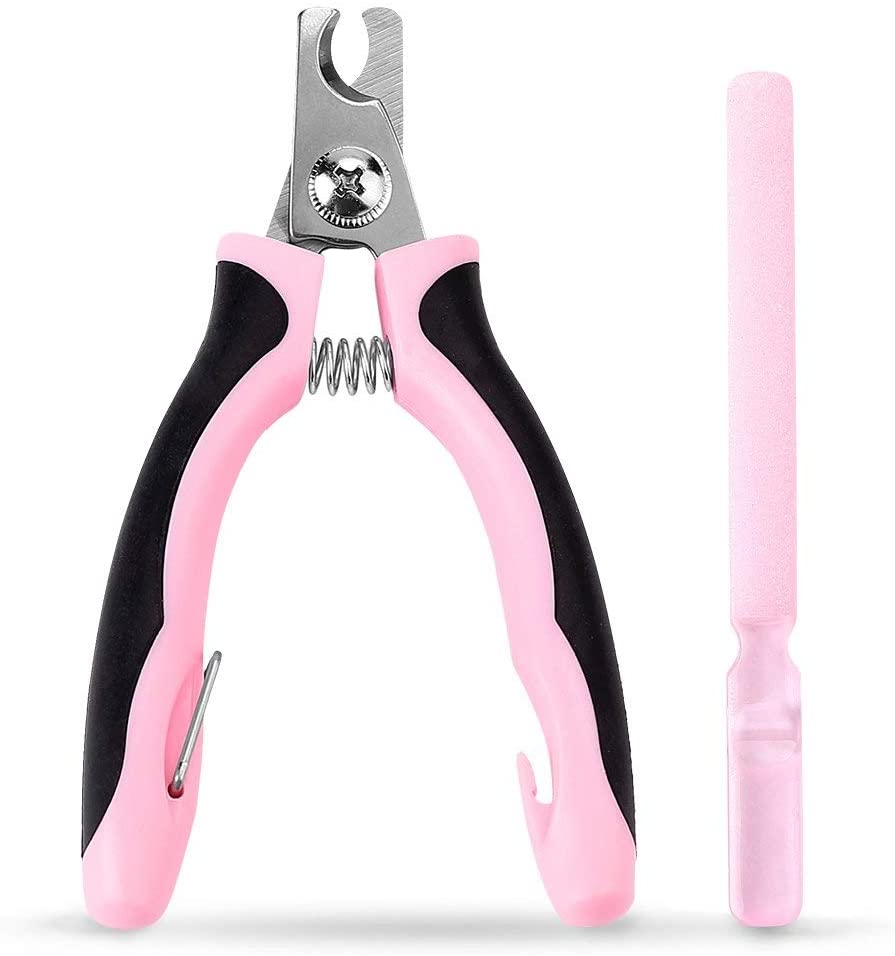
Scratching Posts
Trimming your cat’s claws will make them dull so they won’t be able to do as much damage when they scratch, but nothing will take away their desire. The solution is simple. Give your cat something appropriate to scratch, like a scratching post! Preferably more than one. Place one near any place that your cat previously scratched so they’ll be less likely to keep scratching your sofa or door frames.
Get a good quality, tall, sturdy scratching post or your cat may ignore it in favor of your furniture anyway. The goal is to make the scratching post more appealing to scratch on than any alternatives.
Simple Sleeper Cat Tree
Sprays
There are also sprays made to either deter cats from scratching where they shouldn’t or encourage them to scratch where they should. Cats have a keen sense of smell, so certain scents will go a long way in helping your cat not destroy your furniture.
DeterrentUse anti-scratch sprays in areas where you want your cat to not scratch. These sprays are made to discourage your cat from scratching. The scent is unpleasant to your cat, but not necessarily unpleasant to you.
AttractiveCatnip sprays can be used to encourage your cat to scratch on their scratching posts instead of your furniture. You could also sprinkle some catnip on the scratching post, but a spray is less mess for you to clean up later.
Claw Covers
Claw covers are also available if you feel you need extra help keeping your cat from damaging your furniture. They come in different sizes to fit your cat better and a variety of colors to suit you and your cat’s personalities.
Soft Claws Nail Caps for Cats
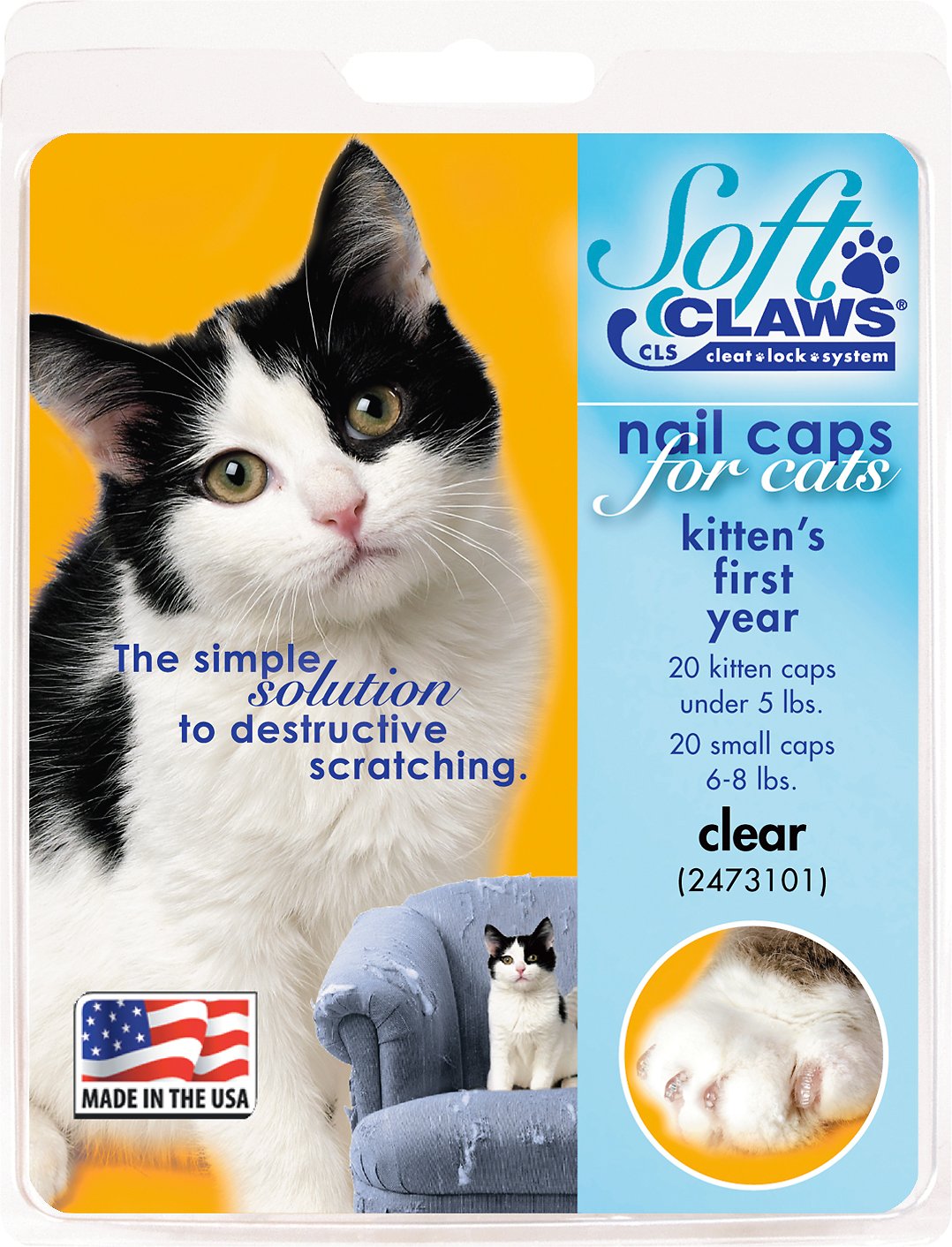
Declawing your cat isn’t good for them and should be avoided unless absolutely necessary. It might even be illegal where you live. There are many ways to help protect you and your furniture from cat scratches, so there’s no need to deprive your cat of the claws they were born with.
Continue reading:
Best Cat Clippers [2022]: Which is Right for Your Needs?


